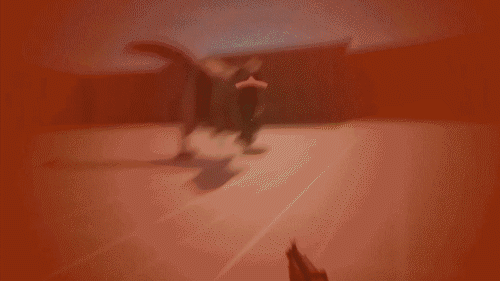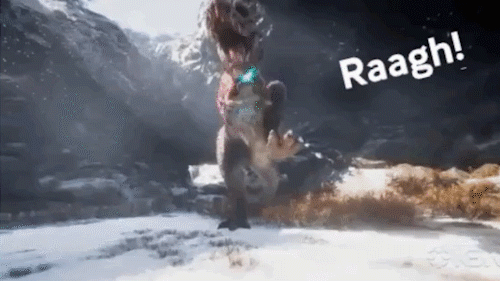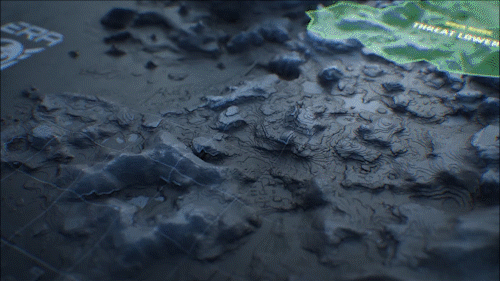Chaos by Design – The Design of Second Extinction
Design, the invisible but fundamental part of a game.
Unlike art, audio, or animation – which are encountered and remembered in instances – design is supposed to run seamlessly and be unnoticeable.
There’s a saying that 99% of design is invisible; you only really notice it when something starts to go wrong. The designer’s job is to think of all the questions that might pop up when you play the game, and not only have answers to them but present them in a way that’s easy to understand.
Here, along with Lead Designer Simon Vickers, we take a deep-dive into the journey of Second Extinction’s design. Simon takes us through the easy wins and unforeseen problems when making a game about the world’s most terrifyingly relentless and awe-inspiring creatures – dinosaurs.
When did you join the Second Extinction dev team?
Just under two years ago now – though time itself feels distorted. At the end of 2018, back when the studio was less than ten people (and one dog!). Now we have about three times that many people (and dogs!).
What has your work-from-home experience been?
It’s been… interesting…
The role of a Designer (and any discipline really) involves a lot of communication. That tends to happen naturally when you’re a few feet from the programmer so you can wander over, have a little play, and have an off the cuff discussion about how to proceed and provide feedback. That all goes away with isolation. We were quite lucky that we were in a place where the game’s central core had been figured out, and our studio has a culture in place that encourages individual ownership and autonomy, so the transition wasn’t as hard as it could have been.

Early dropship blockout vs. now
Working with design, it’s often portrayed that you’re the one who is responsible for “finding the fun” in the game and its features: How did you go about doing that, and is that a fair way of looking at your role?
The use of the word ‘finding’ is very apt, at least at the start of the process. From a concept, there’s an endless number of directions you can travel in, so there’s a lot of feeling things out, poking and seeing what reacts and how.
It’s kind of like cooking a meal, you have a whole lot of delicious ingredients you have at your disposal, but you’re not going to put them all in and end up with something edible. You have to understand what each ingredient brings to the table and how they might interact with one another. Once you’ve got a rough idea of what you will make, you need to communicate that out to the rest of the team who will be responsible for implementing it. There’s a lot of writing, doodling, and chatting with everyone about a feature to ensure everyone gets what you need. Back to the cooking analogy, it’s like asking a food supplier only through descriptions; if you’re making something tomato-y, you need to make sure you’re not just saying ‘I need a round fruit’ and accidentally ending up with an orange.
Then there’s a whole lot of tasting to be done. A concept might work in your head, but you’re working off a lot of best guesses. You need to be able to see how it’s coming together as it goes. Unforeseen problems might show up or, even better, unexpected opportunities for cool things that you can milk for all its worth. It might be that that orange ends up going really well on a pizza.
As a Lead, it’s my responsibility for all the line cooks to have what they need to work efficiently and create all those individual elements to make sure it all comes together tasting great. I’ve made myself hungry now.

Rosy’s Static Barricade early in production vs. now
How has your experience been working with dinosaurs as an enemy type?
It’s been a challenge. Most of my career has been making shooters with traditional ranged, human-ish enemies that come with many easy wins. In combat, they share a very similar goal to that of players, wanting to cover and maintain a safe distance where their weapons are effective. You can plonk enemies into an arena, and you’ll get a beautiful dynamic encounter as players and enemies constantly reposition themselves to get the advantage on one another to achieve that goal.
However, Dinosaurs want and need to get up close and bitey, which means they want to close the distance to the player as quickly and directly as possible. The player’s challenge becomes more about crowd control and trying to take them out before they get close enough to deal damage. Close combat in an FPS can feel very uncomfortable. If we’re not careful as designers, the direct combat experience can devolve simply into running backward and shooting at the closest target, and that was what was happening in our first iterations of the game.
There are plenty of games that manage to do that ranged vs. melee combat thing well, but that’s kind of where we started to see zombies popping up as a common enemy type. They are either slow enough to stay out of the ‘discomfort zone’ or are fast and stupid enough that they’re easy to mow down. We’re making a game about dinosaurs, though, and we wanted to embrace that as best we can and come up with our solutions that let them shine. Our dinosaur designers and animators took many cues from melee action games with plenty of enemy repositioning, windows of opportunity, and clearly defined attack patterns.

T-Rex December 2018

T-Rex July 2020
The community has expressed an urge to play as the dinosaurs – does that surprise you? Was that idea ever considered in the early stages of development, and if so, what made you decide not to?
That doesn’t surprise me at all. It’s the ultimate childhood dream realization, right? We’ve all stomped around as kids (and adults in the case of Jonas) doing the T-Rex arms and doing the roar at some point. It’s a very appealing idea, so of course, it comes up a lot.
We set out to make a co-operative experience first and foremost, which meant establishing a very firm humanity vs. dinosaurs line to get behind. We’re a teeny tiny team, so getting one side of that conflict nailed was crucial and needed our full attention. It is also something that we will continue to develop through the live experience. We can’t rule anything out for the future, though, so who knows…I’m going to regret saying that at some point, aren’t I?
Were you ever faced with an issue when you wanted two features in the game that didn’t work together, and if so, how did you solve it?
All the time! You learn very quickly as a designer not to get too attached to an initial concept for these particular reasons. You need to be flexible and self-critical enough to see when something might need adjusting to fit.
The level of interconnectivity in game development is insane sometimes. It’s usually worth looking outside the two features and seeing if something else is going on further up the chain that could stop those two features from playing nice. If we go back to the point of dinosaurs running at you and the player just running backward, the most obvious suggestions were to slow down the dinosaurs and make the player’s backward run speed slower. This meant punishing the player from doing what it was they instinctively wanted to do. It also meant that our enemies would be dead before they got to the player, which ramped up the frustration when the enemies did get close and meant enemies didn’t get close enough to be a real threat.
What we discovered was that the feeling of enemies being up in your face could be thrilling. We just didn’t have the tools available for the player to deal with it. So we introduced the ability for players to evade. Jumping sideways was essentially pointless, so we switched it out for a much flatter arc, allowing you to dodge attacks coming straight at you. By empowering the player, we were able to make the enemies more aggressive. It was a win-win for a relatively simple tweak!
Suppose something really is incompatible or just doesn’t have the resources available. In that case, it’s often just a simple case of weighing up which feature is the most valuable to the end result rather than on its individual merits. We’ve had to hold back some of our content that is more “out there” as it doesn’t quite fit tonally in the package at this particular point, or had the potential to drain resources from the ‘bread and butter’ of the game.
With Early Access and Live Development, however, it’s much easier to make those calls. Like our dinosaurs, nothing has to stay extinct forever, and if something shows real potential but isn’t quite there yet, we can and will bring it back in a later release.
“What we discovered was that the feeling of enemies being up in your face could be thrilling.”
How did you approach working with progression in the game, and how would you explain how progression works in this game?
Pretty early on, we established that we didn’t want to make a looter shooter in the sense of ever-escalating numbers and randomly-generated weapons. You end up making earlier content obsolete and running the risk of fracturing the player base. We decided to go down the path of having players use their hard-earned winnings to expand the player’s toolkit, then layering in the player’s ability to modify and customize that core toolset to suit their playstyle or the challenge at hand. However, only a limited number of slots are available, encouraging different combinations to play with instead of maxing out a skill tree. Currently, this only applies to player weapons. Still, as the game progresses, we plan to introduce similar approaches to many more aspects of the game with the hope of building depth through choices that interact with one another.
Replayability is often a concern with this type of live service-focused game. How did you make the game fun to play over and over again?
To put it bluntly, we needed to make sure we made shooting dinosaurs fun first. It’s 90 percent of what we’re asking players to do with their time in the game, so if we can nail that and make blasting away as fun the 100th time as the first, then we’ve got some mileage! I find myself getting distracted during playtesting just popping Raptor faces all too often nearly two years into development, so that’s a good sign.
On top of the moment to moment action, we’re adding ways to layer and mix that up in exciting ways. A lot of that comes from the War Effort and the various world systems at play that adds a lot of dynamism during a mission. Even though you’re facing the same objectives, the world throws up little wrinkles in your path to keep you on your toes. ‘Was that Rex there last time?’
Finally, as touched upon earlier, our progression systems’ core is to create and experiment with different loadout configurations for something new to master.
“I find myself getting distracted during playtesting just popping Raptor faces all too often nearly two years into development, so that’s a good sign.”
Could you tell us a bit more about the War Effort? How the feature came to life, and in what ways will it work?
Yes! We established that three of our core pillars of development were Evolution, Replayability, and Cooperation during the game’s planning phase. For those unfamiliar with the concept of pillars, they’re a tool that we set ourselves to refer back to align ourselves in the game’s direction. We should always be asking, ‘does X feature fit into any of those categories?’ In an ideal world, it should manage to fit into all of them.
This led to the concept of the War Effort. A layer that sits above the minute to minute gameplay that reacts to all players’ accomplishments and impacts the world in return, changing it in several ways for when you return. Its most immediately noticeable effect is how it alters our world map regions’ ‘Threat Levels’. If players do well, it is lowered. If not, then it rises, manipulating our in-world systems to present greater challenges in that area. Greater risk means more generous rewards. However, should the community leave an area of high dinosaur presence unchecked for too long, you run the risk of triggering an Emergence Event…

The idea is that the system pulls from a rotating pool of content that we can expand during Early Access and beyond. New game modes, enemies, and missions will be delivered to players in a narrative wrapper that responds to and involves our community.

